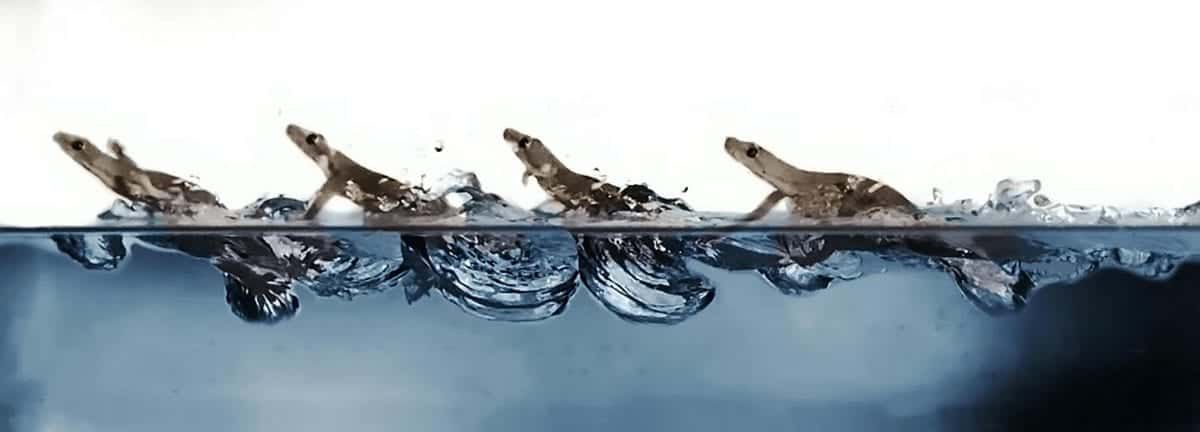
Geckos can run on water at speed by slapping the surface rapidly and using surface tension to keep its body above the surface.
The acrobatic lizards are agile on land sprinting across the ground, able to walk up vertical walls and hang from the ceilings or glide through the air.
Now scientists have found out just how they can scuttle rapidly across the surface of water without ending up going for a swim.
They hold their heads high above the water and extend their limbs out to rapidly slap the water and propel themselves along.
And the findings could one day help robots perform the same feat.
Professor of integrative biology Robert Full of the University of California, Berkeley, said: “They can run up a wall at a metre per second, they can glide, they can right themselves in midair with a twist of their tail and rapidly invert under a leaf running at full speed.
“And now they can run at a meter per second over water. Nothing else can do that; geckos are superheroes.”
Prof Full’s previous research discovered many of the unique manoeuvres and strategies geckos employ, including how their toe hairs help them climb smooth vertical surfaces and hang from the ceiling.
First author Post-Doctoral Research Fellow Jasmine Nirody at the University of Oxford became intrigued by geckos’ water-running behaviour as a PhD student at Berkeley after hearing about how geckos ran across water to escape predators.
Geckos are able to run at nearly a metre, or three feet, per second over water and easily transition to speeding across solid ground or climbing up a vertical surface.
Their sprinting on the water’s surface exceed the absolute swimming speeds of many larger, aquatic specialists including ducks, minks, muskrats, marine iguanas and juvenile alligators, and are faster in relative speed than any recorded surface swimmer, other than whirligig beetles.
But biophysicist Dr Nirody and Prof Full were puzzled by just how they do it.
For example smaller animals like spiders, beetles and water striders are light enough to be kept afloat by surface tension, which allows them to easily glide across the surface.
Larger animals, such as swans during takeoff or the basilisk lizard, and even dolphins rising up on their tails, rapidly slap and stroke the water to keep above the waves.
Prof Full explained: “Bigger animals can’t use surface tension, so they end up pushing and slapping the surface, which produces a force if you do it hard enough.”
As geckos are of intermediate size weighing about six grams or one-fifth of an ounce, they are too large to float above the surface, but too light to keep their bodies above water by slapping forces only.
Dr Nirody said: “The gecko’s size places them in an intermediate regime, a middle ground.
“They can’t generate enough force to run along the surface without sinking, so the fact they can race across water is really surprising.”
So they built a long water tank and placed flat-tailed house geckos common in south and southeast Asia on a plank.
The geckos were startled by having their tail touched and high-speed video recorded their water walking techniques and estimate the forces involved.
The experiments found they actually use at least two and perhaps four distinct strategies to run atop the water surface.
Surface tension is essential because when a surfactant or soap was applied to eliminate surface tension, the geckos were much less efficient with their speed dropping by half.
Even without surface tension, however, they can move using slapping, paddling movements with their four legs like larger animals.
Leg slapping created air pockets that helped keep their bodies from being completely submerged, allowing them to trot across the water in much the same way they run on land.
But they also seem to use their smooth, water-repellent skin to plane across the surface, similar to hydroplaning but referred to as semi-planing, a technique used by muskrats.
Finally, they also use their tail to swish the water like an alligator, providing propulsion as well as lift and stabilisation.
Prof Full said: “All are important to some extent, and geckos are unique in combining all these.”
Dr Nirody added: “Even knowing the extensive list of locomotive capabilities that geckos have in their arsenal, we were still very surprised at the speed at which they could dart across the water’s surface.
“The way that they combine several modalities to perform this feat is really remarkable.”
The study was published in the journal Current Biology.
By Tony Whitfield
Watch